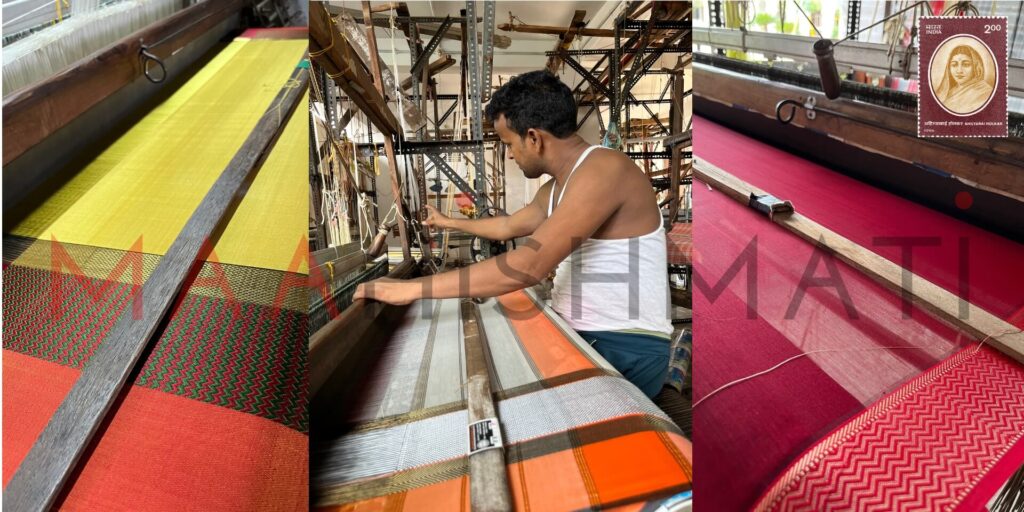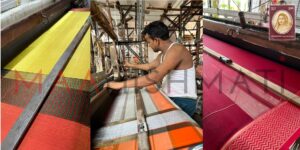
Special on the occasion of the tricentenary birth anniversary of Lokmata Ahilyabai
BY MEDHA BAJPAI
While representing my state in a program in Delhi in freezing temperatures, I wore a Maheshwari tissue saree and I can wear a Maheshwari saree even in the scorching hot temperature of 40 degrees. These sarees make you feel cold in summers and warm in winters.
My love for sarees turned from an obsession to my strength. A way of expressing oneself, this obsession remained even when in the name of modernity women shunned sarees and looked down upon it.
So why should I not be proud of my state and its culture and of Lokmata Ahilya Devi who has blessed us with this emotional gift. The place of women in Indian culture has been highly respected, and from time to time many great women have made unprecedented contributions towards change and empowerment in Indian society.
Lokmata Ahilyabai Holkar of Madhya Pradesh was not only a great ruler, but also a visionary leader who promoted women empowerment and social harmony. The decision to promote the saree industry in Maheshwar during her reign was not only an economic initiative, but it was an important step towards making women self-reliant and establishing equality in society.
Recently, I visited Kanchipuram, a famous place for sarees in South India. While looking at the handicrafts of the world-famous Kanjivaram saree, I spoke with the weavers while wearing the famous Maheshwari silk saree from my Madhya Pradesh. An artisan there told me that this weaving technique is used by the Kanchi weavers, who now make the world-famous Maheshwari sarees of Maheshwar.
Features of Maheshwari Sarees
Maheshwari saree is not just a saree industry. It is Ahilyabai’s visionary self-reliance process, concept of Vocal for Local, administrative efficiency, artistry and ambitious legacy passed on to generations. It is an emotional process of connecting with women.
This aspect of Ahilyabai makes her unique along with her many characteristics. Lok Mata Ahilyabai made Maheshwar her capital and promoted the handloom industry here, which provided employment to women and this industry became famous globally.
The specialty of Maheshwari sarees is that the carvings of the fort are engraved in it. Pure cotton silk and zari are used during weaving. A saree has 54, 56, 58 and 60 threads in one inch.
These sarees are mainly made on looms buried in the ground. It takes 2-15 days to make a saree and its price ranges from Rs 2000 to Rs 2 lakh. Sarees made in Maheshwar are not only famous in India but also exported to many countries of the world. Today, more than 8000 weavers in Maheshwar are making Maheshwari sarees by hand on handlooms.
Maheshwar is 90 km away from Indore city. Situated on the banks of the Narmada river, it is famous for its beautiful and grand ghats and highly artistic temples. The famous debate between Adiguru Shankaracharya and Pandit Mandan Mishra took place in this city. Due to the Narmada river and historical importance, Ahilyabai shifted the capital from Indore to Maheshwar.
She ruled the Holkar dynasty from 1767 to 1795. In 1767, when Ahilyabai announced to take over the reins of the Holkar Empire in adverse circumstances, a section of the society strongly opposed it. The conditions were not easy for women at that time. A section of the society was not ready to accept the rule of a woman.
They thought that how can a helpless and widowed woman run the state. She should worship while staying within limits. But Ahilyabai’s affection, love, service, justice, determination and religious conduct towards her subjects made her a Lok Mata from a queen. She set standards for women empowerment.
Ahilyabai did not follow the purdah system. She prepared a women army and trained them for war. She gave permission to widows to adopt children and the right to use their husband’s property. She was always a visionary for empowerment.
With administrative skills, she undertook pilgrimages across the country and renovated religious temples. While travelling from Badrinath to Rameswaram, she kept thinking about Sanatan and the action plan to maintain the self-reliance of the coming generation and the pride of cultural values.
The foundation of starting the saree industry was laid in the expansion of this thinking and empowerment. Ahilyabai established the Maheshwar region as an important textile industry center. She included women in this industry. She herself designed the first saree, and has given place to the design of the palace carving and the cornice on the border of the traditional Maheshwari saree. How unique was this experiment of preserving our culture for a long time.
Initially, only silk was used in saree manufacturing, later, since cotton was in abundance in the Nimar region, she started manufacturing sarees by mixing cotton and silk. For the sale plan, it was initially used till it was given as a royal gift so that publicity could spread far and wide.
Once it gained fame, its commercial production started. Ahilyabai’s aim was not only to promote textile production, but her move was to highlight the power of women and enhance their role in society. Efforts were made to make local people and natural dyes, cultural heritage, especially women, self-reliant by involving them in this industry.
Social harmony
Ahilyabai gathered weavers from Surat, Bhuj, Patan and Hyderabad. Maratha, Malwa as well as Sindh Ansari, Maru, Salvi, Kholi and Khangar communities were traditional weaver communities who settled in Maheshwar from various parts of India during the reign of Ahilyabai Holkar. The Ninavi community is particularly adept at the traditional art of designing.
The Kanchi Weavers are another weaver community involved in sari manufacturing. This group often produces high quality saris from a blend of silk and cotton. Maheshwar’s sari industry comprises about 30-40% of working women who weave, embroider and embellish the saris, thereby increasing their families’ income by 20-25%.
The visionary decisions of Lokmata Ahilyabai Holkar not only made Maheshwar a hub of textile industry, but also proved to be a significant step towards women empowerment and social harmony. The production of Maheshwari sarees made women self-reliant, gave them equal rights in society and laid the foundation of an empowered and harmonious society. Even today, this industry remains a symbol of Indian culture, art and tradition not only in Maheshwar but in the entire country and the world.
(The author is an educationist and columnist)






https://vitz.ru/forums/index.php?autocom=gallery&req=si&img=4805